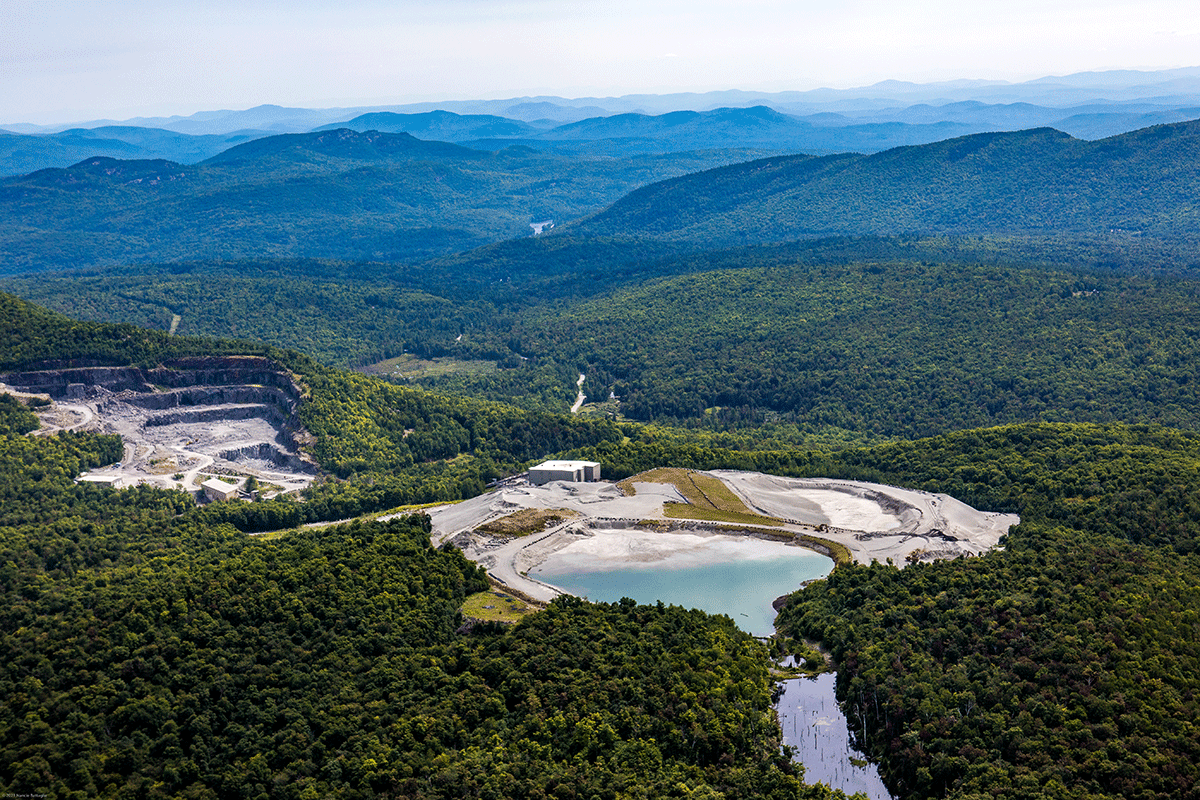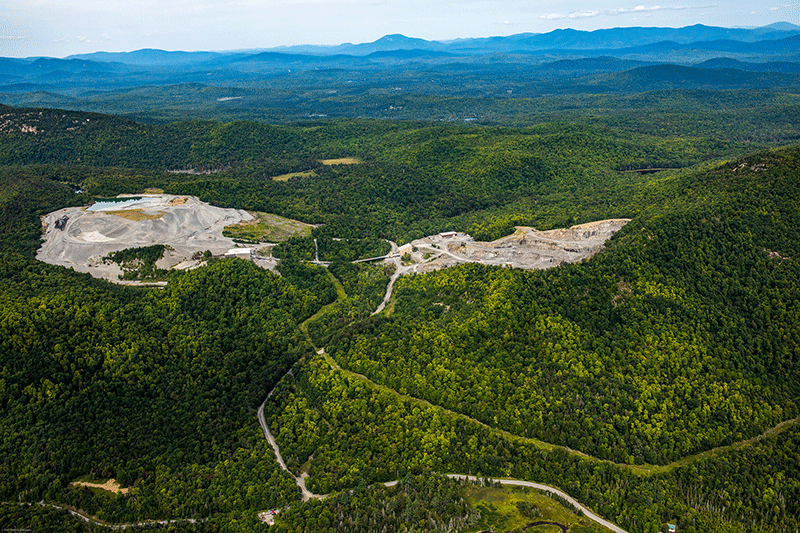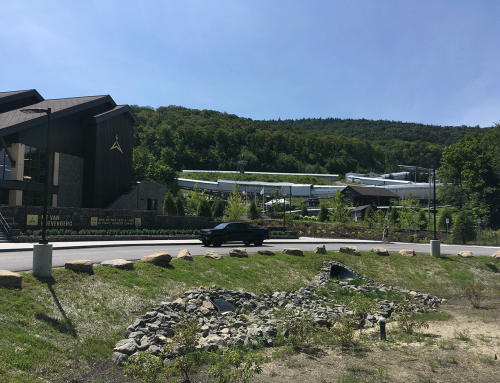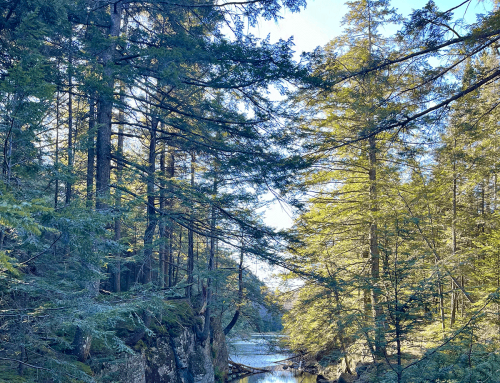The only mountaintop open pit pine in the Adirondacks is planning a major expansion that is currently under review by the Adirondack Park Agency and Department of Environmental Conservation
Barton Mines is planning a wide ranging expansion of its mining operations. The company is seeking to expand its mining footprint by more than one-third from 194.5 acres to 267 acres and has applications pending at the Adirondack Park Agency (APA) and Department of Environmental Conservation (DEC). Barton Mines has a storied history in Warren County and the Adirondack Park. Protect the Adirondacks wishes the company every good fortune as it moves ahead with its plans for expansion. We do, however, believe that the company needs to take seriously the concerns of local residents who live nearby its Ruby Mountain mine and it needs to do more to protect the Forest Preserve.
The company is seeking major changes, such as raising the elevation of its tailings/debris piles, now clearly visible above the tree tops from a number of locations, 100 more feet in height to 2,375 in total elevation. These piles are expected to bury 40 acres. The open pit will reach 17 acres. Barton Mines wants to run its industrial equipment 24 hours a day, which provides no relief for neighbors. Barton Mines is seeking to triple its truck loads driving up and down a steep and twisting County Route 78. Blasting levels will be doubled or tripled. These are all major issues that are critical to local neighbors in the Garnet Hill community that are seeking to live a peaceful rural life. These are also major issues to the many people who seek wilderness experiences in the Siamese Ponds Wilderness area, which borders the mine and is one of the great Wilderness areas in the Adirondack Park.
In short, Barton Mines needs to be a good neighbor. Many of the Barton Mine’s changes, and growth of its mining operations, have been gradual since the mid-1980s. Yet, in the summer of 2022, this modest operation has grown into a large mountaintop mining operation that runs 24 hours a day and seven days a week, which is causing great distress for local residents who are simply trying to enjoy a decent rural quality of life and degrades the surrounding Forest Preserve. The APA and DEC need to be honest brokers and protect the quality of life of local residents who live in the neighborhood around Barton Mines.

The top picture is the Barton Mines on Ruby Mountain is 2021. The picture above is Barton Mines in 1998. The mine has grown considerably in the last 25 years and has a number of offsite impacts on neighboring residences and the Forest Preserve.
Protect the Adirondacks submitted comments to the Adirondack Park Agency in June 2021 concerning the proposed expansion of the 850+/- acres Barton Mines in the Town of Johnsburg, Warren County. Since that time, Barton Mines submitted a permit application in October 2021. The APA issued a Notice of Incomplete Application (NIPA) on November 16, 2021. At this point, Barton Mines has not fully responded to the NIPA. In July 2022, Protect the Adirondacks submitted an updated letter. See also public comments from the Friends of the Siamese Ponds.
There are many issues where Barton Mines needs to improve its management and mining operations. These include community outreach, visual impacts, noise, hours of operation, water quality, fugitive dust, truck traffic, light pollution, impacts to the Forest Preserve, climate change, and final closure design. Additionally, we provide relevant examples from APA permits that required various studies and long-term monitoring of mining impacts on nearby private residences.
Visual Impact: The visual impacts of the existing tailings pile has grown over the years as the tailings pile has grown in elevation. The tailings pile today is clearly visible above the treetops from a number of locations, some as far away as Moxham Mountain. Often, the visual impact is exacerbated by large equipment at work on the pile. Whereas noise pollution cannot be seen, negative visual impacts are clear to the naked eye. The existing negative visual impact is unacceptable, yet Barton Mines is seeking to increase the height of the tailings pile by 100 feet.
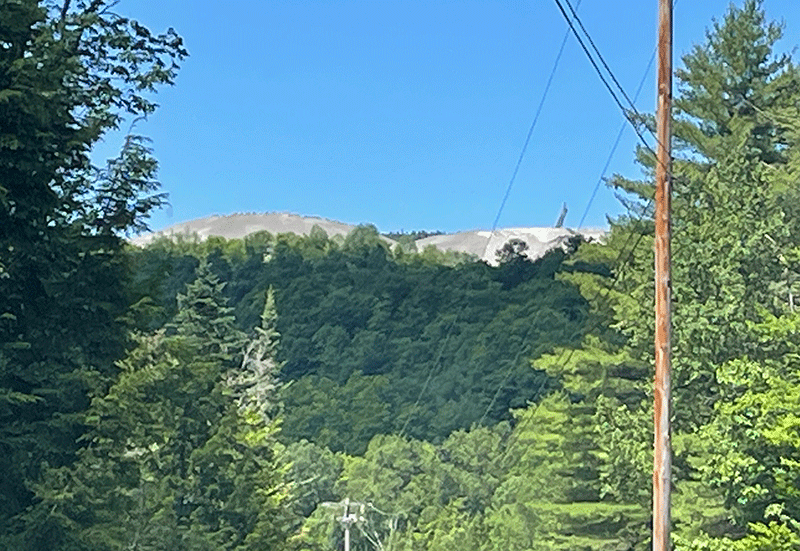
The visual Impacts of the Barton Mines tailings piles has grown. This view is from County Route 78 (Garnet Hill Road). The tailings piles are visible from a number of locations, including from Moxham Mountain in Minerva, and other nearby mountain peaks. Barton Mines wants to raise these tailings piles another 100 feet, yet plans only minimal screening measures.
Noise Impacts: One of the greatest impacts, and perhaps the greatest complaint that we hear from local residents, is the near constant noise coming from the Barton Mine on Ruby Mountain. Long-time local residents tell us that the noise from the mine has grown considerably since the mid-1980s as the mine has moved to 24-hour mining activities. The soundscape of the open pit mountaintop mine on Ruby Mountain has changed considerably and Barton Mine materials say that the mine now has an “amphitheater” effect that projects noise outward from the mine onto the residential community throughout Garnet Hill.
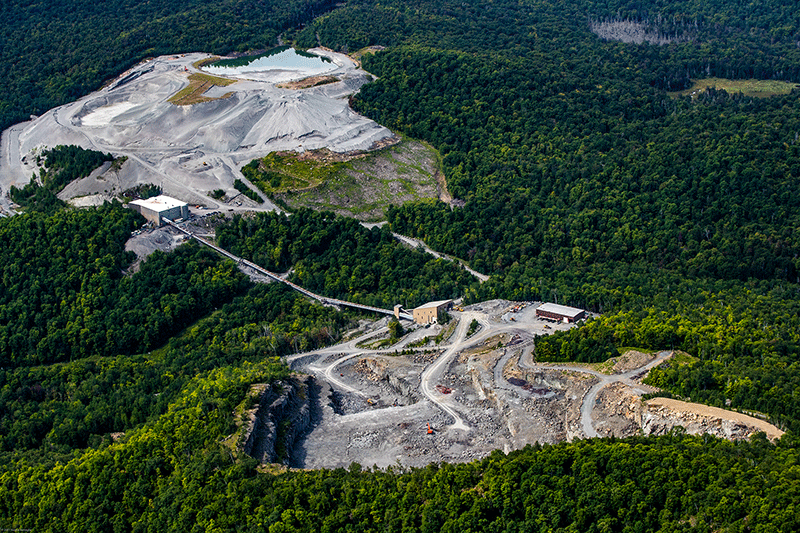
Barton Mines transports materials 24 hours a day from its open put to the processing plant and tailings pile. 24-hour-a-day operations have never been subject to full and fair impact on the quality of life of local residences. Noise during the night is continuous. Noise at all hours of the day is disruptive to the quiet rural quality of life of the residents of the Garnet Hill community.
Enclose Industrial Equipment/Operations to Mitigate Noise Impacts: The APA Notice of Incomplete Application (NIPA) and DEC correspondence have not adequately pressed Barton Mines for information on enclosing buildings where industrial equipment operates or building enclosures where there are currently none. The applicant is seeking a massive expansion and should be made to undertake all measures to mitigate negative noise impacts that disrupt the rural quality of life of many dozens of local residents. Building enclosures should be examined for their benefits to help mitigate noise pollution.
Mandatory Blasting Notifications: Barton Mines is seeking to double or triple the number of blasts per month. The APA NIPA notes “Given the area surrounding the project site is heavily residential to the south and east and includes state land designated Wilderness to the west and north, to ameliorate noise concerns from nearby landowners, please consider amending the blasting plan to exclude blasting onSaturdays.” This response from the APA is inadequate. APA-DEC should require information for how Barton Mines will develop a notification system by email/texts about its blasting schedule with 24 hour and 1 hour notifications. Such schedules have been APA permit requirements in the past and the company should be asked about how it would organize a blasting notification plan. Such a notification plan was done in the NYCO Minerals, Inc. permits in Lewis, NY.
Hours of Operation: The applicant seeks to increase its hours of operation by one hour per day. While this may seem like a minor adjustment, the way in which hours or operation are calculated fails to address the whole issue. Protect the Adirondacks does not see how some mining operations are listed as only allowable during daytime “business” hours, while other industrial activities are somehow exempt for hour/day restrictions and are allowed unfettered 24 hours a day and seven days a week. The APA-DEC must evaluate the “Hours of Operation” issue to include all activities.
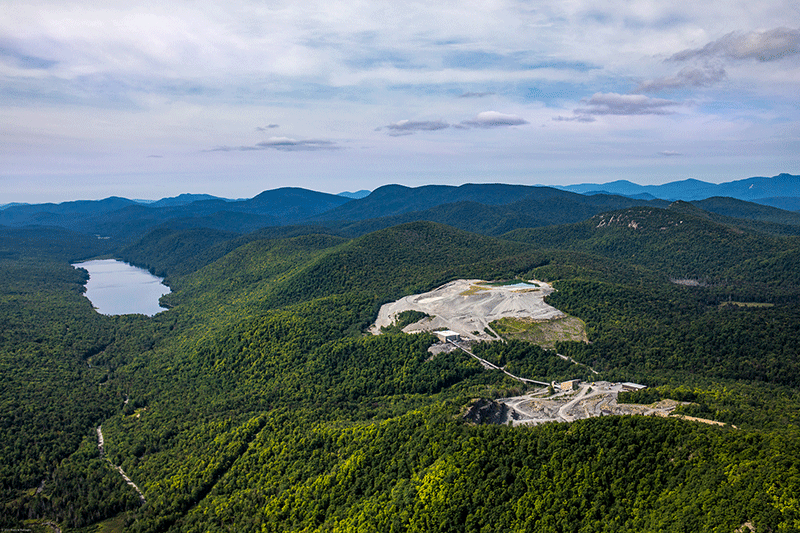
The 24 hour mining activities are the source of perhaps the greatest complaints that we hear from local members and residents on Garnet Hill and up and down County Route 78. We hear complaints of grinding unrelenting noise in the middle of the night and on weekends. With mining activities that run 24 hours a day and seven days a week there is no break for local residents.
24 Hours a Day/Seven Days a Week: APA-DEC correspondence with Barton Mines notes that mining operations on Ruby Mountain will run 24 hours a day and seven days a week. The APA NIPA states “Theexisting operation on the project site operates a mill 24 hours a day, 7 days a week.” Somehow, the 24-hour-7-days-a-week operating schedule is not part of the hours of operation section. We fail to see how only some mine activities are allowable during certain hours, while other activities are in effect unregulated and continuous. With the applicant seeking a permit for another 75 years of mining activities, negative noise impacts from 24-hour-7-days-a-week operations must be addressed and resolved. It unacceptable for local residents and the Forest Preserve to have to endure another 75 years of unmitigated noise pollution from the mine.
The continuous mining activities on Ruby Mountain is one of the major changes from mining activities in the mid-1980s. The decision to expand mining activities to 24 hours a day has never been effectively scrutinized for impacts. Neither the APA NIPA or DEC correspondence has questioned the need for, and impacts of, 24-hour-7-day-a-week mining activities. Neither agency has requested information or plans for how the company will mitigate noise impacts from 24-hour-7-day-a-week mining activities.
Water Quality Impacts: Many local residents have reported instances and sent us pictures of Thirteenth Brook running white due to debris or effluent from Barton Mines. Local anglers report the loss and degradation of the brook trout fishery in the stream. There needs to be an independent scientific analysis of the stream habitat and water quality of Thirteenth Brook. The company also needs to finance a multi-year study of the streams by an independent scientific institution or agent. Proposed groundwater extraction wells adjacent to Thirteenth Brook may be hydraulically connected to the stream and could have deleterious impacts on stream flows. This should be examined by the APA-DEC and a full hydrology study is necessary.
Impacts on the Forest Preserve: Barton Mines borders the Siamese Ponds Wilderness Area, one of the grand Wilderness Areas in the Adirondack Forest Preserve. The mine exports fugitive dust and noise onto the Forest Preserve as well as a visual blight. This is unacceptable. The APA must assess the negative impacts to the Forest Preserve from the Barton Mine activities.
The APA NIPA states: “Given the RM pile is currently located on land designated Resource Management and isproposed to be expanded within the Wilderness Critical Environmental Area (CEA), please evaluate other alternatives that could reduce the proposed expansion of the RM pile.” The applicant has not provided alternatives to encroaching on the Forest Preserve. APA-DEC must continue to press the applicant on the importance of remaining outside of the Wilderness CEA.
The APA NIPA also fails to address impacts on the Forest Preserve more broadly. These include visual impacts from Thirteenth Lake and area hiking trails/peaks, noise, dust, and light pollution.
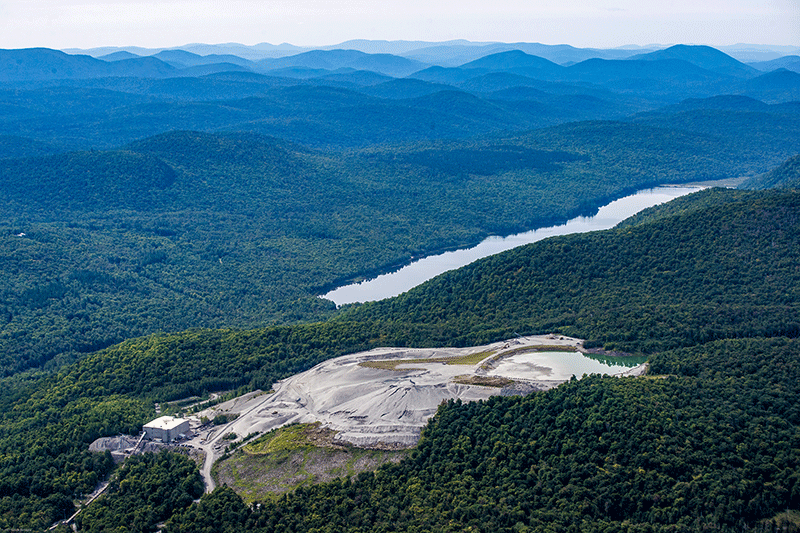
This picture shows Thirteenth Lake in the distance, and the ridges and mountains of the Siamese Ponds Wilderness area, with Barton Mines on its boundary. The mining g company is seeking to mine in the Critical Environmental Area (CEA) within the buffer area to Wilderness lands.
Climate Change: Under the 2019 Climate Leadership and Community Protection Act (CLCPA), state agencies are mandated to weigh the impact of climate change in their decisions. Section 7(2) of CLCPA requires all State agencies to determine whether their administrative approvals are consistent with the attainment of, or will interfere with the attainment of, the statewide greenhouse gas emission limits in ECL Article 75. If inconsistent, they are required to explain why, and to identify alternatives or mitigation measures. In this case, the directive to the APA from CLCPA is to assess the impacts of forest clearing and climate change impacts from a major industrial mining operation. The application materials fail to address this matter.
Protect the Adirondacks is concerned about the APA’s compliance with the Climate Leadership and Community Protection Act. We urge the APA to detail and quantify the climate change impacts of this project, the steps the APA took to mitigate these impacts, and how the APA has complied with the letter and spirit of the Climate Leadership and Community Protection Act. To date, the APA has failed to take into consideration long-term carbon pollution in its review of major projects.
Final Closure Design: In the Barton Mines application, the company wrote “During the final phase of mining, fine-grained residual minerals will be deposited in the northern most portion of the mine (area that enters the CEA). Once the mined-out area is filled with fines it will be reclaimed with topsoil and vegetation.” It is our understanding that state and federal mine lands reclamation laws govern the final disposition of the Ruby Mountain mine. We have included aerial pictures of the former Barton Mine near Gore Mountain where, apparently, no such laws governed the final disposition of those lands. These pictures show open strip mines and unrestored/reforested tailings piles. Given that the company did relatively little to properly close its former mine, we’re hopeful that state agencies will be vigilant to ensure quality restoration and reforestation of the Ruby Mountain mine.
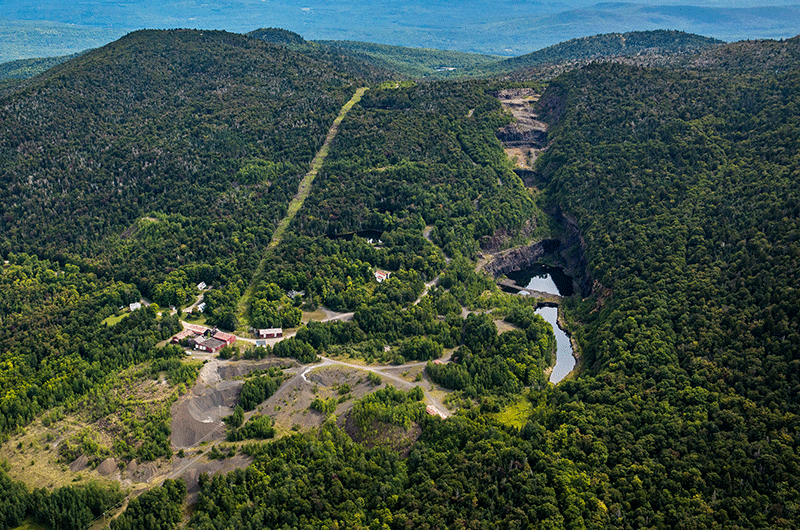
The old, abandoned Barton Mines near Gore Mountain in the Town of Johnsburg, Warren County. This mine pre-existed the Mined Lands Reclamation Act. Open pits remain and open tailings piles remain.
Barton Mines is a longstanding mining operation and processing plant in the Town of Johnsburg, operating for more than 100 years. In much of that time they operated as a good neighbor with area residents. But something has changed. The mine appears to be bulging at the seams and is now causing major negative impacts on the quality of life of local residents. The new APA permit, which will likely govern mine operations for decades to come, must take into consideration these negative impacts and develop a permit that protects the environment and residential rural quality of life of neighboring property owners. Unfortunately, Barton Mines has not been forthcoming with information with neighboring landowners and has taken an aggressive position to dismiss their concerns.
As regulatory agencies, the APA and DEC needs to serve as a honest broker in this project review process. The APA needs to fully assess this project. This project is highly controversial and ripe for an official adjudicatory public hearing.

